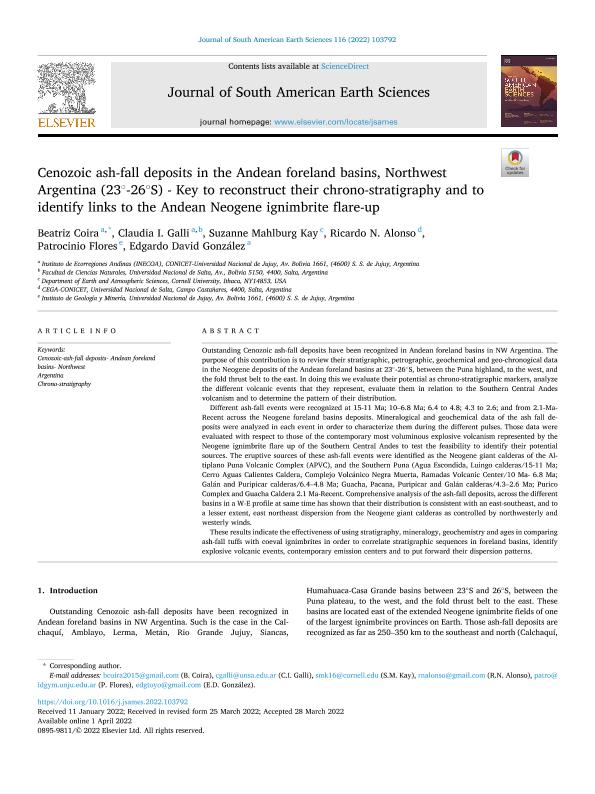Mostrar el registro sencillo del ítem
dc.contributor.author
Coira, Beatriz Lidia Luisa

dc.contributor.author
Galli, Claudia Inés

dc.contributor.author
Mahlburg Kay, Suzanne

dc.contributor.author
Alonso, Ricardo Narciso

dc.contributor.author
Flores, Patrocinio Ismael

dc.contributor.author
Gonzalez, Edgar David

dc.date.available
2023-05-05T15:51:32Z
dc.date.issued
2022-06
dc.identifier.citation
Coira, Beatriz Lidia Luisa; Galli, Claudia Inés; Mahlburg Kay, Suzanne; Alonso, Ricardo Narciso; Flores, Patrocinio Ismael; et al.; Cenozoic ash-fall deposits in the Andean foreland basins, Northwest Argentina (23°-26°S) - Key to reconstruct their chrono-stratigraphy and to identify links to the Andean Neogene ignimbrite flare-up; Pergamon-Elsevier Science Ltd; Journal of South American Earth Sciences; 116; 6-2022; 1-18
dc.identifier.issn
0895-9811
dc.identifier.uri
http://hdl.handle.net/11336/196467
dc.description.abstract
Outstanding Cenozoic ash-fall deposits have been recognized in Andean foreland basins in NW Argentina. The purpose of this contribution is to review their stratigraphic, petrographic, geochemical and geo-chronogical data in the Neogene deposits of the Andean foreland basins at 23°-26°S, between the Puna highland, to the west, and the fold thrust belt to the east. In doing this we evaluate their potential as chrono-stratigraphic markers, analyze the different volcanic events that they represent, evaluate them in relation to the Southern Central Andes volcanism and to determine the pattern of their distribution. Different ash-fall events were recognized at 15-11 Ma; 10–6.8 Ma; 6.4 to 4.8; 4.3 to 2.6; and from 2.1-Ma-Recent across the Neogene foreland basins deposits. Mineralogical and geochemical data of the ash fall deposits were analyzed in each event in order to characterize them during the different pulses. Those data were evaluated with respect to those of the contemporary most voluminous explosive volcanism represented by the Neogene ignimbrite flare up of the Southern Central Andes to test the feasibility to identify their potential sources. The eruptive sources of these ash-fall events were identified as the Neogene giant calderas of the Altiplano Puna Volcanic Complex (APVC), and the Southern Puna (Agua Escondida, Luingo calderas/15-11 Ma; Cerro Aguas Calientes Caldera, Complejo Volcánico Negra Muerta, Ramadas Volcanic Center/10 Ma- 6.8 Ma; Galán and Puripicar calderas/6.4–4.8 Ma; Guacha, Pacana, Puripicar and Galán calderas/4.3–2.6 Ma; Purico Complex and Guacha Caldera 2.1 Ma-Recent. Comprehensive analysis of the ash-fall deposits, across the different basins in a W-E profile at same time has shown that their distribution is consistent with an east-southeast, and to a lesser extent, east northeast dispersion from the Neogene giant calderas as controlled by northwesterly and westerly winds. These results indicate the effectiveness of using stratigraphy, mineralogy, geochemistry and ages in comparing ash-fall tuffs with coeval ignimbrites in order to correlate stratigraphic sequences in foreland basins, identify explosive volcanic events, contemporary emission centers and to put forward their dispersion patterns.
dc.format
application/pdf
dc.language.iso
eng
dc.publisher
Pergamon-Elsevier Science Ltd

dc.rights
info:eu-repo/semantics/openAccess
dc.rights.uri
https://creativecommons.org/licenses/by-nc-sa/2.5/ar/
dc.subject
CENOZOIC ASH-FALL DEPOSITS
dc.subject
ANDEAN FORELAND BASINS
dc.subject
NORTHWEST ARGENTINA
dc.subject
CHRONO-STRATIGRAPHY
dc.subject.classification
Vulcanología

dc.subject.classification
Ciencias de la Tierra y relacionadas con el Medio Ambiente

dc.subject.classification
CIENCIAS NATURALES Y EXACTAS

dc.title
Cenozoic ash-fall deposits in the Andean foreland basins, Northwest Argentina (23°-26°S) - Key to reconstruct their chrono-stratigraphy and to identify links to the Andean Neogene ignimbrite flare-up
dc.type
info:eu-repo/semantics/article
dc.type
info:ar-repo/semantics/artículo
dc.type
info:eu-repo/semantics/publishedVersion
dc.date.updated
2022-07-04T20:17:14Z
dc.journal.volume
116
dc.journal.pagination
1-18
dc.journal.pais
Estados Unidos

dc.journal.ciudad
Amsterdam
dc.description.fil
Fil: Coira, Beatriz Lidia Luisa. Universidad Nacional de Jujuy. Instituto de Ecorregiones Andinas. Consejo Nacional de Investigaciones Científicas y Técnicas. Centro Científico Tecnológico Conicet - Salta. Instituto de Ecorregiones Andinas; Argentina
dc.description.fil
Fil: Galli, Claudia Inés. Universidad Nacional de Jujuy. Instituto de Ecorregiones Andinas. Consejo Nacional de Investigaciones Científicas y Técnicas. Centro Científico Tecnológico Conicet - Salta. Instituto de Ecorregiones Andinas; Argentina
dc.description.fil
Fil: Mahlburg Kay, Suzanne. Departments Of Earth And Atmospheric Sciences, Cornell; Estados Unidos
dc.description.fil
Fil: Alonso, Ricardo Narciso. Consejo Nacional de Investigaciones Científicas y Técnicas. Centro Científico Tecnológico Tucumán. Instituto Superior de Correlación Geológica. Grupo Vinculado al INSUGEO- Centro de Estudios Geológicos Andinos; Argentina
dc.description.fil
Fil: Flores, Patrocinio Ismael. Universidad Nacional de Jujuy. Instituto de Geología Minera; Argentina
dc.description.fil
Fil: Gonzalez, Edgar David. Universidad Nacional de Jujuy. Instituto de Ecorregiones Andinas. Consejo Nacional de Investigaciones Científicas y Técnicas. Centro Científico Tecnológico Conicet - Salta. Instituto de Ecorregiones Andinas; Argentina
dc.journal.title
Journal of South American Earth Sciences

dc.relation.alternativeid
info:eu-repo/semantics/altIdentifier/doi/https://doi.org/10.1016/j.jsames.2022.103792
dc.relation.alternativeid
info:eu-repo/semantics/altIdentifier/url/https://www.sciencedirect.com/science/article/abs/pii/S0895981122000839
Archivos asociados
